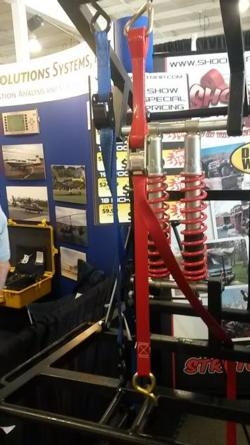Fri, Jul 24, 2015
The Claw And Shock Strap Offer Easy, Reliable Tiedowns
By Maria Morrison
In Wisconsin in late July, thunderstorms and high winds are a given. At AirVenture, where spacing between wingtips rarely exceeds two feet, one snapped tie down can result in a two or three aircraft pileup. Pilots will often leave the airshow periodically to make sure their planes are still attached to the ground. Fortunately, there are a few products and tips that allow pilots to enjoy their day instead of checking on their tie downs every five minutes.

Aircraft-to-ground attachments have two essential parts: the rope that is attached to the strut and the tie down that goes into the ground. The tie down can be anything that digs into the ground, but one of the most common is The Claw, the first product in a line by Millennium Outfitters.
The Claw has been exhibiting at AirVenture for the past ten years as a compactable tie down. It has three legs that produce individual stakes to be driven into the ground at angles so that they can not be pulled out. The Claw works on slopes and requires only good soil, grass or no grass.
The one key to tying down that those at The Claw booth had was to place the tie down straight down from where the rope attaches to the strut. If you attach your tie down to the rope it should hang directly below where the rope is attached. This way, the load is even on all three stakes. Those at The Claw also agree that the rope should not have too much tension, so that the wing can move with the wind a bit.
Although The Claw comes with a rope, there is a first-time exhibitor at AirVenture, Shock Strap, that offers a strap that moves with the airplane without letting go. Shock Strap is a polyester strap with a polyurethane piece that will absorb shock. As owner Fred Gill displays, the normal nylon strap comes off its tiedown when shaken up and down. Shock Strap, however, stayed on, with only the urethane piece moving. The Shock Strap comes in six, ten, and nineteen-foot sizes, and can withstand a load of up to 1500 lbs. Unlike nylon straps, which absorb water, the polyester strap repels water, and does not chafe.
More News
Aero Linx: Model Aeronautical Association of Australia MAAA clubs are about fun flying, camaraderie and community. For over 75 years, the MAAA has been Australia’s largest fl>[...]
Touchdown Zone Lighting Two rows of transverse light bars located symmetrically about the runway centerline normally at 100 foot intervals. The basic system extends 3,000 feet alon>[...]
“Discovery and innovation are central to our mission at Virgin Galactic. We’re excited to build on our successful record of facilitating scientific experiments in subor>[...]
How To Get A Story On Aero-TV News/Feature Programming How do I submit a story idea or lead to Aero-TV? If you would like to submit a story idea or lead, please contact Jim Campbel>[...]
Student Pilot Reported That During Rotation, “All Of A Sudden The Back Of The Plane Kicked To The Right..." Analysis: The student pilot reported that during rotation, “>[...]
 ANN's Daily Aero-Linx (05.02.24)
ANN's Daily Aero-Linx (05.02.24) ANN's Daily Aero-Term (05.02.24): Touchdown Zone Lighting
ANN's Daily Aero-Term (05.02.24): Touchdown Zone Lighting Aero-News: Quote of the Day (05.02.24)
Aero-News: Quote of the Day (05.02.24) ANN FAQ: Contributing To Aero-TV
ANN FAQ: Contributing To Aero-TV NTSB Final Report: Cirrus Design Corp SR20
NTSB Final Report: Cirrus Design Corp SR20



